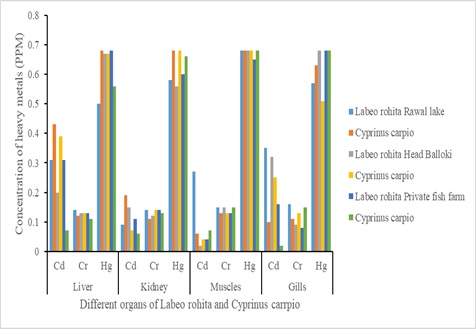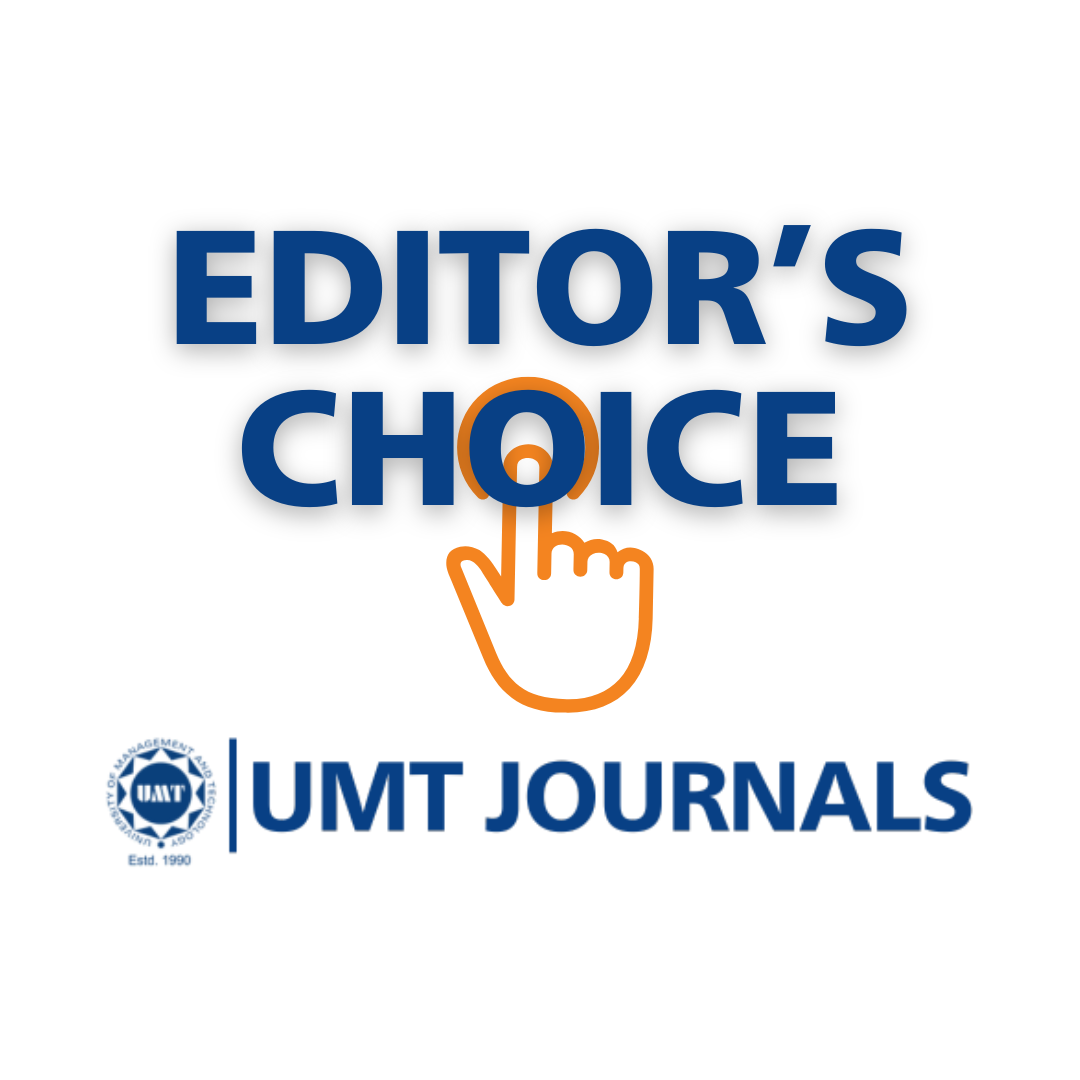Assessment of Heavy Metals Concentration in Different Organs of Labeo rohita and Cyprinus carpio
Abstract
 Abstract Views: 0
Abstract Views: 0
The current study was conducted to assess the concentration of heavy metals in rohu (Labeo rohita) and common carp (Cyprinus carpio). A total of three sites namely Rawal Lake Islamabad, Head Balloki, and a private fish farm in Muridke were selected. Fish were dissected and tissues from the liver, kidneys, gills, and muscles were separated. Chemical digestion of samples was carried out with aqua regia. Three metals namely chromium (Cr), cadmium (Cd), and mercury (Hg) were detected by using atomic absorption spectroscopy in the labs of Pakistan Council of Scientific and Industrial Research (PSCIR), Lahore, Pakistan. All metals were found at a higher level in different tissues of both the fish species. The overall trend of metals in the two fish species namely rohu and carp was recorded as Hg > Cd > Cr. It was observed that the level of Hg remained very high as compared to other metals. Statistical analysis was performed using one-way ANOVA and significant differences at p < 0.001 were noticed for the metals in different organs. While, independent sample t test showed non-significant differences at p > 0.483 between the two fish species. The liver was found to have the highest metal load, followed by the kidneys and gills. The metal load was above the permissible limit set by World Health Organization (WHO). However, the heavy metals concentration in muscles was below the permissible limit. It was noticed that heavy metal contamination was higher in Rawal Lake as compared to the private fish farm. It was concluded that contaminated water bodies are affecting the exposed organisms. So, there is a need to save them from pollutants for the best survival of aquatic life.
Downloads
References
Appannagari RR. Environmental pollution causes and consequences: a study. North Asian Int Res J Soc Sci Humanit. 2017;3(8):151–61.
Sarker B, Keya KN, Mahir FI, Nahiun KM, Shahida S, Khan RA. Surface and ground water pollution: causes and effects of urbanization and industrialization in South Asia. Sci Rev. 2021;7(73):32–41. https://doi. org/10.32861/sr.73.32.41
Chaudhary P, Ahamad L, Chaudhary A, Kumar G, Chen WJ, Chen S. Nanoparticle-mediated bioremediation as a powerful weapon in the removal of environmental pollutants. J Environ Chem Eng. 2023;11(2):e109591. https://doi.org/10.1016/j.jece.2023.109591
Ayilara MS, Adeleke BS, Adebajo MT, et al. Remediation by enhanced natural attenuation; an environment-friendly remediation approach. Front Environ Sci. 2023;11:e1182586. https://doi.org/10.3389/fenvs.2023.1182586
Martins DA, Custódio L, Barreira L, et al. Alternative sources of n-3 long-chain polyunsaturated fatty acids in marine microalgae. Mar Drugs. 2013;11(7):2259–2281. https://doi.org /10.3390/md11072259
Shahidi F, Ambigaipalan P. Omega-3 polyunsaturated fatty acids and their health benefits. Annu Rev Food Sci Technol. 2018;9:345–381. https://doi. org/10.1146/annurev-food-111317-095850
Ahsan MA, Siddique MAB, Munni MA, Akbor MA, Bithi UH, Mia MY. Analysis of major heavy metals in the available fish species of the Dhaleshwari River, Tangail, Bangladesh. Int J Fish Aquat Stud. 2018;6(4):349–354.
Kaur S, Khera KS, Kondal JK. Heavy metal induced histopathological alterations in liver, muscle and kidney of freshwater cyprinid, Labeo rohita (Hamilton). J Entomol Zool Stud. 2018;6(2):2137–2144.
Singh AK, Rana KS, Sharma K. Chromium, nickel and zinc induced histopathological alteration in the liver of Indian common carp Labeo rohita (Ham.). Int Arch Appl Sci Technol. 2019;10(2):49–55.
Tchounwou PB, Yedjou CG, Patlolla AK, Sutton DJ. Heavy metal toxicity and the environment. In: Luch A, eds., Molecular, Clinical and Environmental Toxicology. 2012;3:133-164. Basel: Springer; 2012:133–164. https://doi.org/10.1007/978-3-7643-8340-4_6
Młyniec K, Davies CL, de Agüero Sánchez IG, Pytka K, Budziszewska B, Nowak G. Essential elements in depression and anxiety. Part I. Pharmacol Rep. 2014;66(4):534–44. https://doi.org/10.1016/j.pharep.2014.03.001
Khatun J, Intekhab A, Dhak D. Effect of uncontrolled fertilization and heavy metal toxicity associated with arsenic (As), lead (Pb) and cadmium. Toxicology. 2022;477:e153274. https: //doi.org/10.1016/j.tox.2022.153274
White PJ, Pongrac P. Heavy-metal toxicity in plants. In: Plant Stress Physiology. Wallingford, UK: Cabi Publishing;2017:300–331. https://doi. org/10.1079/9781780647296.0300
Yadav KK, Gupta N, Kumar V, Singh JK. Bioremediation of heavy metals from contaminated sites using potential species: a review. Indian J Environ Prot. 2017; 37(1):65–84.
Ali H, Khan E. Trophic transfer, bioaccumulation, and biomagnification of non-essential hazardous heavy metals and metalloids in food chains/webs—concepts and implications for wildlife and human health. Hum Ecol Risk Assess Int J. 2019;25(6):1353–1376. https://doi. org/10.1080/10807039.2018.1469398
Namieśnik J, Rabajczyk A. The speciation and physico-chemical forms of metals in surface waters and sediments. Chem Spec Bioavail. 2010;22(1):1–24. https://doi.org/10. 3184/095422910X12632119406391
Authman MM, Ibrahim SA, El-Kasheif MA, Gaber HS. Heavy metals pollution and their effects on gills and liver of the Nile catfish inhabiting El-Rahawy Drain, Egypt. Glob Vet. 2013;10(2):103–115. https://doi.org /10.5829/idosi.gv.2013.10.2.71226
Varsha M, Kumar PS, Rathi BS. A review on recent trends in the removal of emerging contaminants from aquatic environment using low-cost adsorbents. Chemosphere. 2022;287(3):e132270. https://doi.org/ 10.1016/j.chemosphere.2021.132270
Velma V, Vutukuru SS, Tchounwou PB. Ecotoxicology of hexavalent chromium in freshwater fish: a critical review. Rev Environ Health. 2009;24(2):129–145. https://doi.org/1 0.1515/reveh.2009.24.2.129
Baby J, Raj JS, Biby ET, et al. Toxic effect of heavy metals on aquatic environment. Int J Biol Chem Sci. 2010;4(4):939–952. https://doi.org/10.4314/ijbcs.v4i4.62976
Malik RN, Hashmi MZ, Huma Y. Heavy metal accumulation in edible fish species from Rawal Lake Reservoir, Pakistan. Environ Sci Pollut Res Int. 2014;21(2):1188–1196. https://doi.org/10.1007/s11356-013-1992-3
Yılmaz AB, Turan C, Toker T. Uptake and distribution of hexavalent chromium in tissues (gill, skin and muscle) of a freshwater fish, tilapia, Oreochromis aureus. J Environ Chem Ecotoxicol. 2010;2(3):28–33.
Gall JE, Boyd RS, Rajakaruna N. Transfer of heavy metals through terrestrial food webs: a review. Environ Monit Assess. 2015;187(4):e201. https://doi.org/ 10.1007/s10661-015-4436-3
Mason LH, Harp JP, Han DY. Pb neurotoxicity: neuropsychological effects of lead toxicity. BioMed Res Int. 2014;2014:e840547. https://doi. org/10.1155/2014/840547
Sany SBT, Salleh A, Rezayi M, Saadati N, Narimany L, Tehrani GM. Distribution and contamination of heavy metal in the coastal sediments of Port Klang, Selangor, Malaysia. Water Air Soil Pollut. 2013;224(4):1–18.
Poudel MB, Awasthi GP, Kim HJ. Novel insight into the adsorption of Cr(VI) and Pb(II) ions by MOF derived Co-Al layered double hydroxide@hematite nanorods on 3D porous carbon nanofiber network. Chem Eng J. 2021;417:e129312. https://doi.org/10.1016/j.cej.2021.129312
Hessel EVS, Staal YCM, Piersma AH, den Braver-Sewradj SP, Ezendam J. Occupational exposure to hexavalent chromium. Part I. Hazard assessment of non-cancer health effects. Regul Toxicol Pharmacol. 2021;126:e105048. https://doi.org/ 10.1016/j.yrtph.2021.105048
Teklay A. Physiological effect of chromium exposure: a review. Int J Food Sci Nutr Diet. 2016;7:1-11.
Abdel-Mohsien HS, Mahmoud MA. Accumulation of some heavy metals in Oreochromis niloticus from the Nile in Egypt: potential hazards to fish and consumers. J Environ Prot. 2015;6(09):e59608. https://doi.org /10.4236/jep.2015.69089
Lee WK, Thévenod F. Cell organelles as targets of mammalian cadmium toxicity. Arch Toxicol. 2020;94(4):1017–1049. https://doi. org/10.1007/s00204-020-02692-8
Sun Q, Li Y, Shi L, et al. Heavy metals induced mitochondrial dysfunction in animals: molecular mechanism of toxicity. Toxicology. 2022;469:e153136. https://doi.org/ 10.1016/j.tox.2022.153136
Karim A, Iqbal A, Akhtar R, et al. Barcoding of fresh water fishes from Pakistan. Mitochondrial DNA A DNA Mapp Seq Anal. 2016;27(4):2685–2688. https://doi.org/10.3109/19401736.2015.1043544
Rafique M, Khan NUH. Distribution and status of significant freshwater fishes of Pakistan. Rec Zool Surv Pak. 2012;21:90-95.
Zulqurnain S, Sultana S, Sultana T, Mahboob S. Fatty acid profile variations after exposure to textile industry effluents in Indian Major Carps. Braz J Biol. 2022;84:e254252. https://doi.org/10.1590/1519-6984. 254252
Zhang Y, Zhang P, Li Y. Gut microbiota-mediated ferroptosis contributes to mercury exposure-induced brain injury in common carp. Metallomics. 2022;14(1):emfab072. https://doi.org/10.1093/mtomcs/mfab072
Paul EA, ed. Soil microbiology, Ecology and Biochemistry. Academic Press; 2014.
Rajeshkumar S, Li X. Bioaccumulation of heavy metals in fish species from the Meiliang Bay, Taihu Lake, China. Toxicol Rep. 2018;5:288–295. https://doi.org/10. 1016/j.toxrep.2018.01.007
Rajeshkumar S, Liu Y, Ma J, Duan HY, Li X. Effects of exposure to multiple heavy metals on biochemical and histopathological alterations in common carp, Cyprinus carpio L. Fish Shellfish Immunol. 2017;70:461–472. https://doi.org/10.1016/j.fsi.2017.08.013
Wang W, Wang S, Ma X, Gong J. Recent advances in catalytic hydrogenation of carbon dioxide. Chem Soc Rev. 2011;40(7):3703–3727. https://doi.org/10.1039/c1cs15008a
Hong YJ, Liao W, Yan ZF, et al. Progress in the research of the toxicity effect mechanisms of heavy metals on freshwater organisms and their water quality criteria in China. J Chem. 2020;2020:1–12. https://doi.org/10. 1155/2020/9010348
Rehman AU, Nazir S, Irshad R, et al. Toxicity of heavy metals in plants and animals and their uptake by magnetic iron oxide nanoparticles. J Mol Liq. 2021;321:e114455. https://doi.org/10 .1016/j.molliq.2020.114455
Rehman K, Fatima F, Waheed I, Akash MSH. Prevalence of exposure of heavy metals and their impact on health consequences. J Cell Biochem. 2018;119(1):157–184. https://doi.org/ 10.1002/jcb.26234
Yasmeen R, Muhammad HA, Bokhari SS, Rafi U, Shakoor A, Qurashi AW. Assessment of heavy metals in different organs of cattle egrets (Bubulcus ibis) from a rural and urban environment in Pakistan. Environ Sci Pollut Res Int. 2019;26(13):13095–13102. https://doi.org/10.1007/ s11356-019-04814-x
Yasmeen R, Shaheen S, Khan BN, Bokhari SS, Rafi U, Qurashi AW. Faecal matter of spotted deer (Axis axis) acts as bioindicator of heavy metals contamination in the air. Pak J Zool. 2020;52(2):e813. https://doi.org/ 10.17582/journal.pjz/20181214041244
Devi NL, Yadav IC. Chemometric evaluation of heavy metal pollutions in Patna region of the Ganges alluvial plain, India: implication for source apportionment and health risk assessment. Environ Geochem Health. 2018;40(6):2343–2358. https://doi. org/10.1007/s10653-018-0101-4
Adimalla N, Wang H. Distribution, contamination, and health risk assessment of heavy metals in surface soils from northern Telangana, India. Arab J Geosci. 2018;11:1–15.
Ahmed ASS, Sultana S, Habib A, et al. Bioaccumulation of heavy metals in some commercially important fishes from a tropical river estuary suggests higher potential health risk in children than adults. PLOS ONE. 2019;14(10):e0219336. https://doi. org/10.1371/journal.pone.0219336
Zhong W, Zhang Y, Wu Z, Yang R, Chen X, Yang J et al. Health risk assessment of heavy metals in freshwater fish in the central and eastern North China. Ecotoxicol Environ Saf. 2018;157:343–349. https://doi.org/10.1016/j.ecoenv.2018.03.048
Li H, Jing T, Li T, et al. Ecotoxicological effects of pyraclostrobin on tilapia (Oreochromis niloticus) via various exposure routes. Environ Pollut. 2021;285:e117188. https://doi.org/10.1016/j.envpol.2021.117188
Khalil A, Jamil A, Khan T. Assessment of heavy metal contamination and human health risk with oxidative stress in fish (Cyprinus carpio) from Shahpur Dam, Fateh Jang, Pakistan. Arab J Geosci. 2020;13:e928. https://doi.org/10.1007/ s12517-020-05933-3
Oyugi DO, Cucherousset J, Baker DJ, Britton JR. Effects of temperature on the foraging and growth rate of juvenile common carp, Cyprinus carpio. J Therm Biol. 2012;37(1):89–94. https://doi.org/10.1016/j. jtherbio.2011.11.005
Maurya PK, Malik DS. Bioaccumulation of heavy metals in tissues of selected fish species from Ganga river, India, and risk assessment for human health. Hum Ecol Risk Assess Int J. 2019;25(4):905–923. https://doi.org/10.1080/10807039.2018.1456897
Maurya PK, Malik DS, Yadav KK, Kumar A, Kumar S, Kamyab H. Bioaccumulation and potential sources of heavy metal contamination in fish species in River Ganga basin: possible human health risks evaluation. Toxicol Rep. 2019;6:472–481. https://doi. org/10.1016/j.toxrep.2019.05.012
Ahmad MK, Islam S, Rahman S, Haque M, Islam MM. Heavy metals in water, sediment and some fishes of Buriganga River, Bangladesh. Int J Environ Res. 2010;4(2):321–332
Kousar S, Javed M. Heavy metals toxicity and bioaccumulation patterns in the body organs of four fresh water fish species. Pak Vet J. 2014;34(2):161–164.
Rajeshkumar S, Li X. Bioaccumulation of heavy metals in fish species from the Meiliang Bay, Taihu Lake, China. Toxicol Rep. 2018;5:288–295. https://doi.org /10.1016/j.toxrep.2018.01.007
Batvari B, Prabhu D, Kamalakannan S, Krishnamurthy RR. Heavy metals accumulation in two fish species (Labeo rohita and Cirrhina mrigala) from Pulicat Lake, North of Chennai, Southeast Coast of India. J Chem Pharm Res. 2015;7(3):951–956.
Javed M, Usmani N. Assessment of heavy metal (Cu, Ni, Fe, Co; 2013, Cr, Zn) pollution in effluent dominated rivulet water and their effect on glycogen metabolism and histology of Mastacembelus armatus. Spring Plus. 2013;2:e390. https://doi.org/10.1186/ 2193-1801-2-390
Ujah II, Okeke DO, Okpashi VE. Determination of heavy metals in fish tissues, water and sediment from the Onitsha segment of the river niger Anambra State Nigeria. J Environ Anal Toxicol. 2017;7(507):2161–0525. https://doi.org/10.4172/2161-0525. 1000507
Khan MI, Khisroon M, Khan A, et al. Bioaccumulation of heavy metals in water, sediments, and tissues and their histopathological effects on Anodonta cygnea (Linea, 1876) in Kabul River, Khyber Pakhtunkhwa, Pakistan. BioMed Res Int. 2018;2018:e1910274. https://doi.org/10.1155/2018/1910274
Jabeen F, Chaudhry AS, Manzoor S, Shaheen T. Examining pyrethroids, carbamates and neonicotenoids in fish, water and sediments from the Indus River for potential health risks. Environ Monit Assess. 2015;187(2):e29. https://doi.org/ 10.1007/s10661-015-4273-4
Zhao S, Feng C, Quan W, Chen X, Niu J, Shen Z. Role of living environments in the accumulation characteristics of heavy metals in fishes and crabs in the Yangtze River Estuary, China. Mar Pollut Bull. 2012;64(6):1163–1171. https://doi.org/10.1016/j.marpolbul.2012.03.023
Görür FK, Keser RE, Akçay Nİ, Dizman SE. Radioactivity and heavy metal concentrations of some commercial fish species consumed in the Black Sea Region of Turkey. Chemosphere. 2012;87(4):356–361. https://doi.org/10.1016/j.chemosphere.2011.12.022
Ebrahimpour M, Pourkhabbaz A, Baramaki R, Babaei H, Rezaei M. Bioaccumulation of heavy metals in freshwater fish species, Anzali, Iran. Bull Environ Contam Toxicol. 2011;87(4):386–392. https://doi.org /10.1007/s00128-011-0376-y
Karunanidhi K, Rajendran R, Pandurangan D, Arumugam G. First report on distribution of heavy metals and proximate analysis in marine edible puffer fishes collected from Gulf of Mannar Marine Biosphere Reserve, South India. Toxicol Rep. 2017;4:319–327. https://doi.org/10. 1016/j.toxrep.2017.06.004
Nawaz S, Nagra SA, Saleem Y, Priyadarshi A. Determination of heavy metals in fresh water fish species of the River Ravi, Pakistan compared to farmed fish varieties. Environ Monit Assess. 2010;167(1-4):461–471. https://doi.org/10.1007/s10661-009-1064-9
Iqbal J, Shah MH. Study of seasonal variations and health risk assessment of heavy metals in Cyprinus carpio from Rawal Lake, Pakistan. Environ Monit Assess. 2014;186(4):2025–2037. https://doi.org/10.1007/s10661-013-3515-6
Henry RP, Lucu C, Onken H, Weihrauch D. Multiple functions of the crustacean gill: osmotic/ionic regulation, acid-base balance, ammonia excretion, and bioaccumulation of toxic metals. Front Physiol. 2012;3:e431. https://doi.org /10.3389/fphys.2012.00431
Sarkar S, Biswas A, Purkait T, Das M, Kamboj N, Dey RS. Unravelling the role of Fe–Mn binary active sites electrocatalyst for efficient oxygen reduction reaction and rechargeable Zn-Air batteries. Inorg Chem. 2020;59(7):5194–5205. https://doi.org /10.1021/acs.inorgchem.0c00446
Saleh YS, Marie MAS. Assessment of metal contamination in water, sediment, and tissues of Arius thalassinus fish from the Red Sea coast of Yemen and the potential human risk assessment. Environ Sci Pollut Res Int. 2015;22(7):5481–5490. https://doi. org/10.1007/s11356-014-3780-0
Tapia J, Vargas-Chacoff L, Bertrán C, et al. Heavy metals in the liver and muscle of Micropogonias manni fish from Budi Lake, Araucania Region, Chile: potential risk for humans. Environ Monit Assess. 2012;184(5):3141–3151. https://doi. org/10.1007/s10661-011-2178-4
Liu JL, Xu XR, Ding ZH, Peng JX, Jin MH, Wang YS et al. Heavy metals in wild marine fish from South China Sea: levels, tissue- and species-specific accumulation and potential risk to humans. Ecotoxicology. 2015;24(7-8):1583–1592. https://doi.org/10 .1007/s10646-015-1451-7
Jia Y, Wang L, Qu Z, Wang C, Yang Z. Effects on heavy metal accumulation in freshwater fishes: species, tissues, and sizes. Environ Sci Pollut Res Int. 2017;24(10):9379–9386. https://doi.org/10.1007/s11356-017-8606-4

Copyright (c) 2023 Dr. Roheela Yasmeen, Amina Zulfiqar, Syeda Shazia Bokhari, Syeda Shazia Bokhari, Muhammad Amjad Khan

This work is licensed under a Creative Commons Attribution 4.0 International License.
BSR follows an open-access publishing policy and full text of all published articles is available free, immediately upon publication of an issue. The journal’s contents are published and distributed under the terms of the Creative Commons Attribution 4.0 International (CC-BY 4.0) license. Thus, the work submitted to the journal implies that it is original, unpublished work of the authors (neither published previously nor accepted/under consideration for publication elsewhere). On acceptance of a manuscript for publication, a corresponding author on the behalf of all co-authors of the manuscript will sign and submit a completed the Copyright and Author Consent Form.









